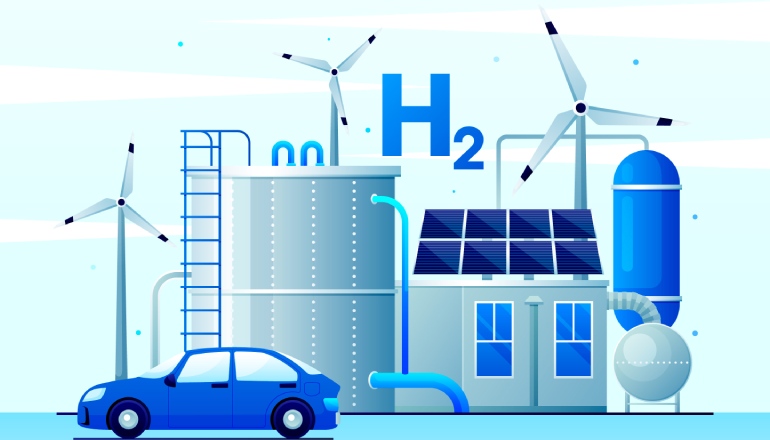On the occasion of the 75th Independence Day celebration, Prime Minister Narendra Modi made a critical announcement to make “India Energy Independent Nation by 2047.” A nation that is on an energy transformation journey has integrated different energy sources, including green hydrogen.
India, the world’s third-largest economy in terms of energy needs, faces a 35% surge in energy demand by 2030. It requires non-traditional energy generation methods to achieve net-zero emissions by 2070.
The country has set ambitious targets to phase down fossil fuel consumption. The set targets are 50% of power generation from RE, 5 million tonnes of hydrogen, and 30% of EV penetration by 2030.
India constituted the National Green Hydrogen Mission in the year 2022 as an answer to energy security and emission reduction. The country, in the last budget (2023 February), has allocated Rs 197 billion for the mission. And it aims to be an exporting hub for green hydrogen.
However, the country’s green hydrogen production is lagging behind its target.
Challenges
- The cost factor
- Storage cost
- Tax rebates and subsidies
- Duty cuts
- The gap in demand from the industry
- Investment challenges
- Technology maturity
- R&D and innovation
The cost of green hydrogen is twice as high as gray hydrogen, with 30-50% going towards electrolyzer costs and the remaining towards renewable electricity.
To supply (round-the-clock) RTC energy, India must reduce the cost of energy storage. Thanks to indirect cost subsidies, batteries and other energy-storing devices could become less expensive. Customs duty exemptions or goods and services taxes are other possible forms of intervention.
A new report titled Green Hydrogen: Enabling Measures Roadmap for Adoption in India suggests ways to increase green hydrogen capacity in the country.
Authors Sachin Kotak, Partner, Bain & Company, and Jörgen Sandström, Head, Transforming Industrial Ecosystems, World Economic Forum, recommend a reduction in production costs to $2 per kg, with a direct subsidy of $0.50/kg for early adopters.
What will drive green hydrogen in the country?
Four types of users are likely to drive green hydrogen adoption: existing gray hydrogen users, industrial processors, transportation providers, and power and heating companies. Demand-side interventions should be tailored for each user, such as promoting blended hydrogen, which combines green and gray hydrogen with minimal impact on final product costs.
According to the authors, industrial clusters, consisting of co-located companies, can significantly reduce transportation and storage infrastructure costs, offer tech scale-up opportunities, share risk/resources, and optimize energy demand.
Responsible for 30% of global CO2 emissions, these clusters can accelerate green hydrogen adoption. The Transitioning Industrial Clusters Towards Net Zero initiative encourages participation. India could encourage cluster participation by allowing companies to bid for incentives and sharing success stories. The EU’s Hydrogen Backbone program could also benefit.
Four types of users are likely to drive green hydrogen adoption: existing gray hydrogen users, industrial processors, transportation providers, and power and heating companies. Demand-side interventions should be tailored for each user, such as promoting blended hydrogen, which combines green and grey hydrogen with minimal impact on final product costs.
India’s low-cost renewable energy, skilled workforce, and abundant land make it a potential hub for green hydrogen derivative exports. To capitalize, stakeholders should improve port infrastructure, allowing green hydrogen and ammonia manufacturers to establish storage bunkers near ports.
Subsidies:
More actions, such as increased PLI scheme subsidy support, are required to lower the cost of electrolyzers drastically and, consequently, green hydrogen.
India should encourage green hydrogen adoption and disincentivize carbon-intensive energy sources by diverting subsidies and funds towards green energy transition through a comprehensive carbon-tax regime.
Additionally, the country can increase direct subsidies for early adopters to drive down the cost of electrolyzers. During the first year of electrolyzer production, the Indian government provided $54/kW in subsidies through a production-linked incentive (PLI). The first tranche operated from July to October of 2023. Nevertheless, the cost of producing green hydrogen has only decreased by $0.1/kg thanks to this subsidy. To significantly lower the cost of electrolyzers and, consequently, green hydrogen, further interventions are required, such as increased subsidy support through the PLI scheme.
The National Green Hydrogen Mission:
The Indian government launched the National Green Hydrogen Mission in 2022 to address energy security and combat emissions in hard-to-abate sectors, but there is limited on-the-ground traction.
The 2022 national program aims to reduce dependence on imports of fossil fuel and feedstock and create export opportunities for Green Hydrogen and its derivatives to help the world fight climate.
It must be noted that as part of its Union Budget for 2023, India removed customs taxes on imported lithium-ion batteries for electric vehicles, potentially leading to a 20% price drop. Similarly, to promote the production of green hydrogen, India may exempt imported battery storage parts for RTC renewable energy.
In a nutshell:
- India’s green hydrogen production costs are currently $4-5/kg, double the cost of gray hydrogen.
- To reduce production to $2/kg, India could lower energy storage, provide renewable electricity, and implement indirect subsidies.
- Increase direct subsidies for early adopters to reduce electrolyzer costs.
- Minimize costs related to conversion, storage, and transport of green hydrogen and its derivatives by creating industrial clusters, promoting blended hydrogen, and capitalizing on India’s export potential.
- Divert investments away from carbon-intensive alternatives and into greener pathways through a comprehensive carbon-tax regime.
- Implementing easier measures can significantly impact India’s transition from an energy importer to an exporter, creating a win-win solution for energy security, economic growth, and environmental sustainability.

